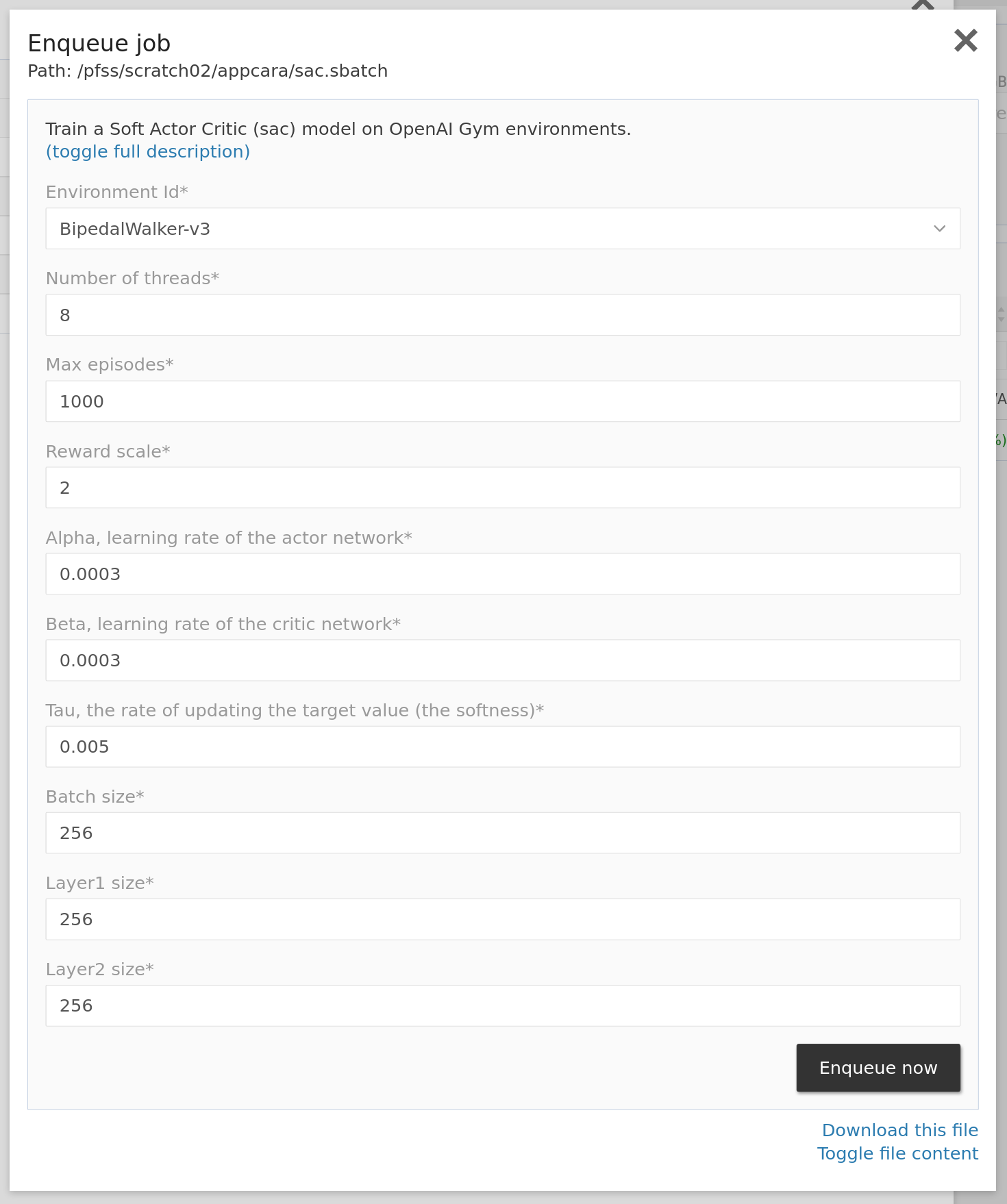Quick jobs
Quick job is one of our web portal's features. It is an excellent way to unify and speed up your team's workflow. For example, you may define what computing resources are required, what software to use, and where the output goes. You may also expose options to your teammate to fine-tune an individual run.
Quick jobs are typical .sbatch scripts. The portal will open a job launcher window when one clicks a .sbatch file. Then you customize the launcher behavior by optional metadata.
Below is a multi-GPU deep reinforcement learning task with a custom description and several exposed options.
#!/usr/bin/env bash
#SBATCH -J sac
#SBATCH -o sac.out
#SBATCH -p gpu
#SBATCH -n 8
#SBATCH -N 1
#SBATCH -c 4
#SBATCH --gpus-per-task a100:1
#SBATCH --mem-per-cpu=16000
<<setup
desc: Train a Soft Actor Critic (sac) model on OpenAI Gym environments.
inputs:
- code: env_id
display: Environment Id
type: dropdown
default: BipedalWalker-v3
options:
- BipedalWalker-v3
- LunarLanderContinuous-v2
- AntBulletEnv-v0
- InvertedPendulumBulletEnv-v0
- CartPoleContinuousBulletEnv-v0
- PongNoFrameskip-v4
required: true
- code: num_threads
display: Number of threads
type: text
default: 8
required: true
- code: max_episodes
display: Max episodes
type: text
default: 1000
required: true
- code: reward_scale
display: Reward scale
type: text
default: 2
required: true
- code: alpha
display: Alpha, learning rate of the actor network
type: text
default: 0.0003
required: true
- code: beta
display: Beta, learning rate of the critic network
type: text
default: 0.0003
required: true
- code: tau
display: Tau, the rate of updating the target value (the softness)
type: text
default: 0.005
required: true
- code: batch_size
display: Batch size
type: text
default: 256
required: true
- code: layer1_size
display: Layer1 size
type: text
default: 256
required: true
- code: layer2_size
display: Layer2 size
type: text
default: 256
required: true
extra_desc: |+
output model will be stored in ./sac_model
loss for each episode is plotted to ./sac_loss.png
setup
module load GCC/11.3.0 OpenMPI/4.1.4
mpiexec singularity exec --nv \
--env env_id=%env_id% \
--env num_threads=%num_threads% \
--env max_episodes=%max_episodes% \
--env reward_scale=%reward_scale% \
--env alpha=%alpha% \
--env beta=%beta% \
--env tau=%tau% \
--env batch_size=%batch_size% \
--env layer1_size=%layer1_size% \
--env layer2_size=%layer2_size% \
/pfss/scratch02/appcara/gym.sif python sac.pyThere is a section colored orange that defines how it interfaces with users. It is in YAML format and consists of three sub-sections: desc, inputs, and optional extra_desc. The launcher renders the below form to capture the user's input. The system expects placeholders in format %input_code% in the file content and will replace them with the user input.
The built-in quick jobs
The three built-in quick jobs discussed in the previous section are also made of the above syntax. You may find them in the parallel file system.
- Jupyter Lab in /pfss/toolkit/start_jupyter.sbatch
- VNC in /pfss/toolkit/start_vnc.sbatch
- Run container in /pfss/toolkit/run_container.sbatch
